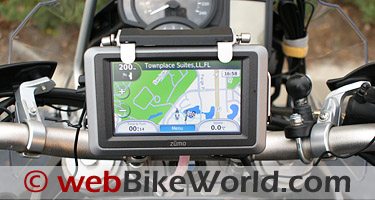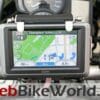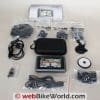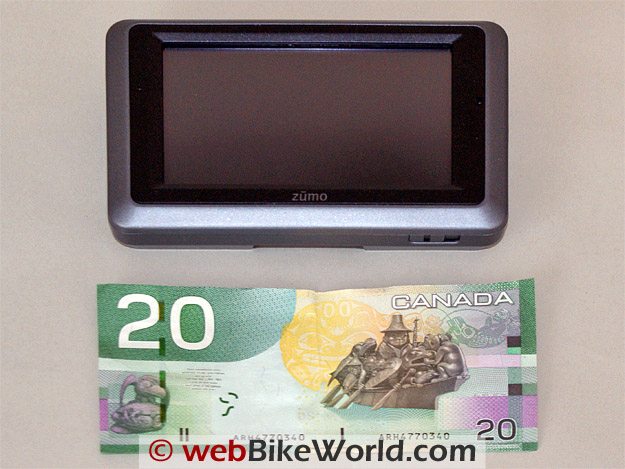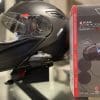One for the road, the zūmo 660 isn’t the “perfect” navigation device yet, but it has enough enhancements over the zūmo 550 and competitors’ products to make it a contender.
The zūmo 660 is larger, brighter and the very crisp display is one of the best features for me.
Outside of the odd time-out when processing, the system is darn fast and responsive, especially when drawing the maps and features, including 3-D mode.
But newer is not always totally better and depending on what the individual consumer or user is looking for, the 660 will be just about perfect, or seen to be lacking certain necessities.
The choice is yours.
I do not regret buying one and even though it does not have everything on my adventure-touring requirements list, I hope Garmin will see fit to evolve it to the extent possible….
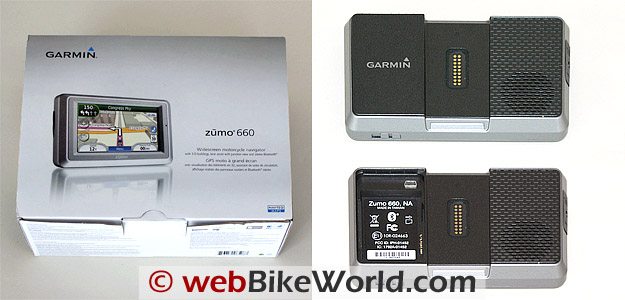
Part 1: Introduction
Garmin has come a long way since an informal beginning in 1989, although its goal, “to create navigation and communication devices that can enrich our customer’s lives” has remained unchanged.
Their innovative and comprehensive product listing provides something for virtually every application and lifestyle imaginable and their user base is truly global in nature.
The extremely popular zūmo (Spanish for “juice” or “squash”; i.e., to get the most out of something) products are marketed under Garmin’s “On the Road” category that covers automotive, motorcycles, trucking and traffic services.
The zūmo 660 is the latest in the Garmin motorcycle GPS lineup; for almost three years, the zūmo 550, later joined by its now discontinued younger 450 sibling, occupied this unique user territory.
Garmin touted the zūmo 550 to an eager audience as having been designed specifically for ‘bikers”, aka motorcyclists.
In very short order the 550, along with one or two other competitors, became the navigation standard for motorcyclists and so many other powered transportation enthusiasts and all for good reason.
Between the box contents, the device features and an ability to survive prolonged periods of rough use, the zūmo models remain complete packages.
They were truly made for life on the road — either mounted on a motorcycle, used in a four-wheeler or dismounted for portability.
But in fast-forwarding to the latter part of 2009, the zūmo line (or rather some of its features, depending on user requirements), became limited and ‘long in the tooth’.
And with the 450 discontinued, the 550 remained the only motorcycle-specific model offered by Garmin in a continually expanding market.
Last year there was a fair amount of confusion over whether the zūmo line was going to be extended or if something from the Garmin nüvi product line was going to be pushed forward.
Trying to find out and figure out what Garmin was up to proved to be somewhat frustrating. In the end however, we were presented with the zūmo 660.
Garmin’s extensive nüvi GPS line is relatively mature and it is upon this baseline that the zūmo 660 is built. Leveraging newer technologies have resulted in a more modern device with lots of enhancements, albeit more evolutionary rather than revolutionary.
Building it to withstand the rigors of motorcycle use makes it unique.
Anyone familiar with navigation devices, especially those built for motorcycle use will quickly recognize the Garmin zūmo 660 for what it is. Opening up a zūmo 550 box was a give-away in determining its intended use; opening up a 660 kit does nothing to change that.
All the basic bits-n-pieces needed to install the device on most motorcycles and get the user navigating out of the box are still there.
From a user perspective, some key features of the zūmo 660 include lane assist, 3-D building view, photo navigation, Where Am I?, Bluetooth wireless, vocalization of street names and optional FM traffic alerts.
The kit also includes preloaded street maps for North America.
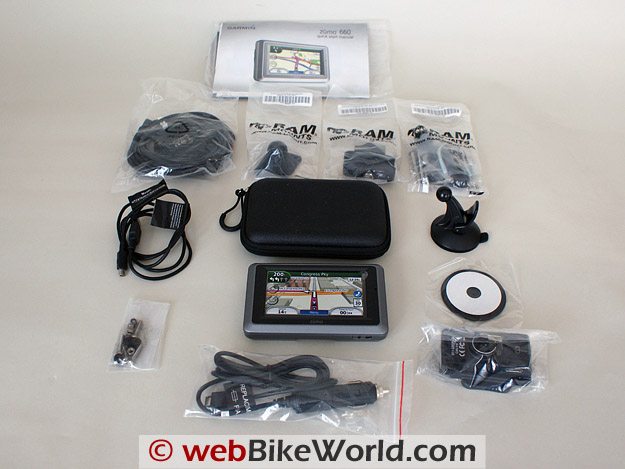
A Rocky Start
My initial experience with a zūmo 660 was not exactly positive.
Anxious to get an early look at one, I had borrowed a fellow BMW club member’s unit for a couple of days earlier this summer, just to see how/if it was going to work with the Bluetooth Communications Systems that I was evaluating at the time.
This initial effort ended quickly when the Bluetooth feature disabled itself after my initial pairing attempt with the Biker Com Control Box (review) and refused to come back.
Resetting the zūmo 660 didn’t work and it finally took a “Clearing User Data” reset to recover the system, with some resultant loss of data.
A “Clearing User Data” reset is engaged by holding a finger on the lower-right corner of the screen while turning on the device.
Keep the finger pressed on the screen until the query message appears, touch “Yes” to clear all user data. Note: this deletes all user-entered information and all original (factory) settings are restored.
Strangely enough, this experience finally drove me to order a zūmo 660 for myself. Five days later I had my own unit to try and break. I repeated the initial pairing attempt — with the same result.
Even with the system restored, it refused to pair with any of the sets on hand, even though I knew it worked with the Cardo Q2 system (review),, as that is what the club member was using.
While the zūmo 660 saw the devices, a secured connection could not be established…hmm. But to be fair, the unit was fresh out of the box and I knew that Garmin had been busy releasing updates on a regular basis.
A few minutes of letting the Garmin WebUpdater application work away brought the zūmo 660 up to the latest baseline.
What a difference! The device ran appreciably faster and best of all the Bluetooth feature performs comparatively or better than the tried and true zūmo 550 and Navigator III+ devices. A new ball game begins…
Uniqueness Counts
The first thing I noticed about the zūmo 660 is its weight…it feels heftier even though it is actually close to the same weight as the 550.
Its svelte 16:9 shape, symmetric case and understated styling makes for a good first appearance; having lots of new worth-while features doesn’t hurt either.
Although relatively new to market, the Garmin zūmo 660 may be on its way to joining its older sibling as a highly desirable device. This will be due in large part to its design, build and durability.
These traits are important, especially when the device is exposed to the elements for prolonged periods of time. A tradeoff of sorts is that the device tends to be slightly larger and typically heavier than other less qualified units.
Motorcyclists are typically an ingenious lot.
As such, many have adopted other navigation devices of all types for use and, the accessory market has been pretty quick in responding to providing innovative solutions to help these devices cope with the elements.
Part of this situation comes about due to the limited market for motorcycle specific devices and the additional costs associated with designing, producing and marketing said devices.
One of the most specific and most demanding requirements for a motorcycle-specific device is that it must withstand the elements.
To this end, both the Garmin 550 and zūmo 660 are designed and tested to IPx7 certification standards.
IPx7 is part of the IEC 60529 European system of test specification standards for classifying the degrees of protection, i.e., provided by enclosures for electrical equipment.
What does this really mean? Well, in this instance, it is claimed that the zūmo 660 could be immersed in one meter of water for up to 30 minutes and survive. Have I tried this specific test yet? No. Do I have confidence in the certification?
After using two zūmo 550 units, over the past two years — yes.
More information on the IPx7 standards can be found at www.iec.ch or this Wikipedia perspective.
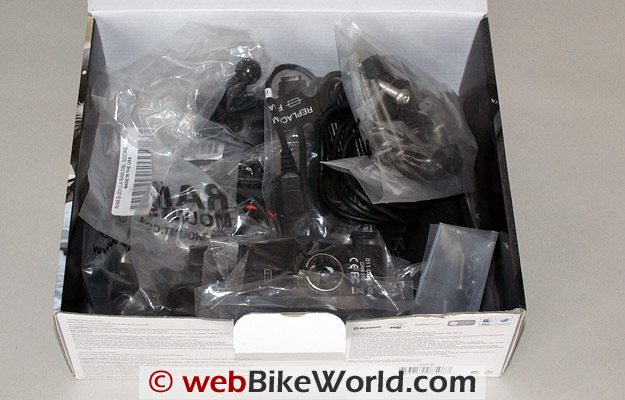
In The Box
UUpon first opening the Garmin zūmo 660 box to reveal the top layer that cradles the GPS unit itself, everything seemed to be in order but removing the first layer revealed a literal mess of components underneath — some bagged and some not.
It was obvious that the box had been opened once or twice and not repacked with any degree of care or order.
As the shipment had come directly from the vendor in Calgary nestled inside a larger shipping box, itself tightly sealed upon receipt, I was starting to wonder…
After taking some pictures of the box and its contents, everything got unpacked and inventoried. There is no packing list or content listing in the included media, but this is what I ended up with:
- Garmin zūmo 660 GPS unit.
- zūmo mounting cradle or bracket with integral 15-pin connector and interface harness.
- RAM-B-309-7U Clutch/Brake U-Bolt kit.
- RAM-B-347U Base Mount.
- RAM-B-201U Double socket arm (medium).
- Bag of hardware bag (for securing base mount and cradle together).
- Hard plastic weather cap (for motorcycle cradle use only).
- USB cable for data connection and charging.
- MMedia package that includes the DVD required to initialize, register the system and get the mapping software and tools installed on a computer.
Another surprise – opening the media bag and checking numbers revealed that the serial numbers on the registration slip and the unit itself did not match…ouch!
Wanting to avoid a prolonged registration session with Garmin, I sent an email off to the vendor with the obvious question — what gives?
Twenty four hours later I had a response. Apparently many Garmin zūmo 660 units were returned to the plant for ‘fixes’, repacked and shipped back out. My mismatch was likely due to this activity.
I was assured that there would be no problems and two days later I registered the device, downloaded the map update and applied a bunch of firmware releases, all without issue.
Conclusion
On the surface I like the new zūmo 660. Even though it lacks things that I admire in the 550, envy in other systems and expected to see in this model, the 660 is still a step up in general and a big step up in some areas specifically.
The display is great, processing and presentation of map data is fast and switching between applications virtually seamless.
Finally having a stereo music stream via Bluetooth is great, although on rare occasion the Bluetooth output is less than stellar. I think that issue may possibly be related to the wireless services when the device is running off its battery.
I have been accumulating more time and distance with the 660 and using it for more challenging activities.
These include the really long complex trips that result in lots of calculations, routes, changes and trip logs.
Also, I rely on the device to provide dead reckoning and orientation advice, entertain me via its media services and host multiple communications devices, some of the sheen is wearing off.
The 550 made a real impression on the motorcycling community: by the same token it raised expectations for any sibling or successor.
Right now I’m not sure if the 660 is going to remain a competent sibling or be seen as a worthy successor to the 550.
I do know that having to wait another two years or so for a 770 model that may or may not meet widely known requirements will be frustrating.
UPDATE (January 8, 2010): Garmin announced the Garmin zumo 665 Widescreen Motorcyle Navigator at the 2010 CES show in Las Vegas.
The zumo 665 carries an astronomical list price of $999.99 USD (Street price: $799.99).
It features a claimed battery life of 5 hours; a 4.3″ touch screen; XM radio antenna and ability to stream XM radio to Bluetooth speakers; XM NavWeather to display NEXRAD weather images; MP3 player; A2DP and more. Available now.
| Garmin zūmo 660 Review: | |
| ▪ 1: Introduction to the the zūmo 660 | |
| ▪ 2: Physical Tour | |
| ▪ 3: Where To? | |
| ▪ 4: Using the zūmo 660 | |
| ▪ 5: zūmo 660 Specifications | |
| ▪ 6: zūmo 550 vs. 660 Comparison | |
| ▪ 7: Installation | |
| ▪ Owner Comments (On Page 1) | |
Owner Comments and Feedback
See details on submitting comments.
From “J.L.” (November 2015): “First let me say that I use my Zumos along with the mapping software to create routes. I don’t typically put in an address and follow the directions provided by Zumo.
I purchased both of these devices for my husband and I, paying a great deal of money … I just found out within the past few months that these Zumos only work with MapSource.
Garmin has walked away from MapSource and substituted BaseCamp, which is by no means as user friendly as MapSource.
Worse than that, after spending all that money on the Zumos, plus the expensive Touratech mounts, I was informed that I can’t design a map in Base Camp and transfer it to either of my Zumos. Garmin hasn’t updated MapSource since 2010. MapSource works inconsistently.
Recently I tried to design a route and I got a MapSource error message whereupon it deleted the map altogether. I tried everything. I repeatedly redesigned the route using different distances between waypoints; Rebooted MapSource; Rebooted my computer. Everything I could think of.
It still deleted the map at the same place each time.
Another problem I often run into when designing a route in MapSource is that when I put a waypoint down, the routing line (magenta, in my case) goes past the waypoint and then circles back.
It is often difficult to get past that. I have worked with Garmin support repeatedly over these issues and really there is no “cure” because they don’t care about MapSource anymore.
Working with BaseCamp is a chore, but I would do it if I could transfer the routes to my Zumos.
One of the most basic criticisms I have about BaseCamp is that unlike every software package I have ever used, I can’t click on “New (route)” and get a clean screen. The map I was working on before remains on the screen.
I am told that I need to create a “New List” instead of “New Route”. That means that for every route I design, I need to create a New List. This leaves me with a column of New Lists.
One would think that a List would contain numerous routes, but that is not the case here.
Essentially, you have to “work around” BaseCamp. It doesn’t make me happy that I paid over $2000 for these two Zumos plus mounts and Garmin essentially made them difficult to work with. Even so, using a paper map to ride makes no sense.
My only option is to plunk down yet more money for a newer Zumo that will work with BaseCamp.”
From “P.D.” (March 2015): “I know this Garmin Zumo 665 isn’t new now but I keep running into things with how it works.
One of the most obvious is that while two people can and do frequently ride on one motorcycle the Zumo series can only pair with one Bluetooth headset. My wife wants to listen to the XM too.
So I bought a Sena SM10 and connected it. Now we can both hear stereo Bluetooth music. Great. However since my phone is paired to the Garmin I need a microphone connection. With my Scala G4 I can’t get that through the Sena SM10.
I could probably pair the phone directly to the Scala but then I lose the touchscreen and phone handling features of the Garmin.
I think the Sena SMH10 headsets will pass music through but I don’t have those or the money to buy them. So I decided to hook my helmet up to the Garmin via Bluetooth and my wife’s helmet up to the Sena SM10. My wife hears music right up until I connect my helmet to the Garmin.
I’m guessing Garmin shuts down the audio out cable when it has a Bluetooth connection. *sigh* I’m going to contact Garmin next to see what they say.”
From “V.L.” (November 2014): “I’ve been bubbling for years to rant about this American junk, unfortunately it’s as good as all the other makes get. It just winds me up how they can make their claims to be “biker friendly”.
Forget all the bells and whistles, what you want is a screen you can see, controls that you can use with gloves and “Where am I right now”. The zumo 660 delivers none of this.
As a seasoned tourer I know a bit about Sat Navs and how to use them: “Only when necessary”. It seems that Garmin think they know it all, apparently they “talked to bikers” and developed these devices.
Well in my opinion one of their guys in the office give it a test run one weekend going to the pub and it seemed OK.
Basically they’ve followed the touchscreen models for cars (that’s OK), then made it waterproof and deemed it “Designed for Bikers”.
You cannot see the screen in sun light, You cannot operate the screen with gloves, and on a road 100 miles long it cannot tell you where you are on it, even the junction numbers aren’t shown.
Well, what I mean is that in previous models the intersections you where approaching showed up on the top of the screen, the zumo only tells you what road your on. I know that — where am I on it??!!!
The Zumo 550 is a better model basically because the control buttons are on the left side (clutch hand free) and not sensitive to mis-hitting them. But if you want to know how a sat nav should work, get yourself a Quest 1 or 2.
It’s packed with on screen information; unfortunately they didn’t develop it to it’s conclusion, because they saw the chance to sell the same car device to bikers.
So to conclude, don’t bother buying the latest Zumo, save yourself a fortune and just get a good second-hand Zumo 550 that you can at least operate safely.
In my opinion the Americans haven’t a clue about real motorcycling and bikers’ needs.
You need big buttons on the left Garmin!!! A screen you can read!!! And some information on the screen!!! Don’t give us that rubbish about uncluttering. I’m still fuming, I’ve tried to keep it short.”
From “N.W.” (July 2012): “Excellent reviews so far, just wanted to add my comments regarding the Zumo 660.
I’ve been using a TomTom Rider in the UK for a little over a year, it was functional and worked well. I was tempted to get a Garmin Zumo 660 when after being fed into the back of one traffic queue (or filtering experience as we call them in the UK).
I heard that the Zumo 660 could have an FM traffic receiver added on with lifetime traffic updates for the UK.
I duly paid for the unit, and then a GTM-21 FM Traffic receiver (for some reason this arrived later). Having had a Touratech (mount) on my TomTom, I ordered a lock for the Garmin, and it works a treat.
Sadly the same is not true of the GTM-21 traffic receiver which it seems is only compatible with the automotive mount, the biker gets “poor relation” simple USB connector as opposed to the much larger GTM-21 smart-phone style mount.
I contacted Garmin support on their Freephone number, and was informed that the product documentation did not make it clear that the GTM-21 could only be used in automotive mount and bikers had to use the much more primitive GTM-12 which was less accurate.
I don’t want to use the Garmin in the car (Volvo V70 has one all of its own). I’ve had the GTM-12 on the bike for a week, and it’s still not found the FM transmission signal so I’ll be taking an hour tomorrow to contact Garmin Support again.
I took the unit to Switzerland for a weeks waterproofing test, and it seemed to work fine, but did need a reset as it failed to provide basic information such as ETA and distance.
On the whole, I think its slower to redraw than the TomTom and I do find it seems to have lots of blank screens at intersections.
It also seems to interfere with the IPhone 4 and SCHUBERTH SRC and often has gaps in music transmission, so I might not have it configured properly. On the whole its fine, but I do miss the TomTom Rider (perhaps I need to put them both on).”
From “R.W.” (June 2012): “I have spent a few days playing with my newly acquired Zumo 660. Prompted by a question on ADVrider, I have written down my observations so far.
The Zumo 660 is now a more established product than when you reviewed it for the first time — and the new Zumo 350 could be possibly replacing, it if not for the lack of an MP3 player.
Still, you may want to use my notes; riders still seem to be making up their minds about current choices. And your excellent site helps — it really provides a great source of evaluations and of feedback on motorcycling accessories.
I am on the fence with regard to the 660, for the time being. It’s a great new shiny gadget, so how could I not love it? But… While I did not spend much time with earlier Zumos, I have an extensive experience with the whole long family of StreetPilots.
I spent last few days with both my SP2820 and the Zumo 660 mounted next to each other on the dashboard of my SUV. It’s a duel of British-language Emilies!
Which brings up a weird observation to start. Both units are set for British pronunciation, but American text. However, the Zumo Emily uses British expressions, like “take the slip road”, while the StreetPilot Emily tells me to “take the ramp”. Interesting.
First user experience, once I got over the “new & shiny” excitement, was lukewarm. Necessitated by lack of buttons, the Zumo interface requires more involved navigation between menus.
The only real shortcut I found is the long press of the “Back” button, which takes you to the main screen. That is wrong; it should go back to Map since the user is more likely to have jumped out of Map screen when drilling down some adjustment menus.
Also, some features seems to be missing. There is no “GPS Info” showing acquired satellites and exact time – contrary to description in Help. Map detail has less selection granularity: it offers only high-normal-low choices. High detail is too high; too many POI’s clutter the map.
My big performance comparison test took place today. I was dropping my nephew off, for a flight out of JFK. The awful traffic mess this morning resulted in me taking the “scenic route” through surrounding highways as well as city streets of Jersey City, Manhattan and Brooklyn.
Both receivers got a great workout and I could compare their operation side by side, for a long time and in various environments.
Zumo seems to have a better receiver; it subjectively had less instances of lost reception than the SP2820 and it recaptured signal slightly quicker coming out of tunnels.
The big negative was in routing. Both units were set for Shortest Time routing (my standard mode of navigating; when riding just for fun, I use only the map screen).
Over a combination of highways and busy streets here in the NYC metro area, several times, the Zumo calculated a route leading through city streets.
My knowledge of the area suggested traveling on highways as much as possible — and that was also the selection made by the StreetPilot. Zumo’s city route had an ETA about a minute sooner than the StreetPilot’s highway route, out of about an hour remaining on the route.
Apparently, Zumo’s algorithm is too optimistic about the time spent in city traffic, as if assigning too short a time to traffic-light effects or using too high expected average speed.
On my way back from the airport, no longer in a hurry, I actually let Zumo’s Emily lead me into streets of Elizabeth and Union, New Jersey — instead of StreetPilot’s Emily’s (and mine) choice of the New Jersey Turnpike — just to see what happens.
The result was a tremendous loss of time, about 50% of ETA, mostly due to stop lights, since the traffic was light by then. I do understand that no routing algorithm is perfect and can be often trumped by local knowledge.
What I found disappointing was that several times the StreetPilot made the “correct” selection, while the Zumo not.
Both units are using similar vintage (2011) of City Navigator maps. That, of course, only matters if you use the receiver to navigate to a destination — and if you know the area enough to get a sense that you are being waylaid.
If you only use it to roam about, just to look at the map to find where you are, it is likely that this quirk would not bother you.
Not a glowing endorsement, huh?”
From “R.B.” (September 2011): “Have had the unit for some months. Rode in a torrential downpour (caused flooding in the UK) without a problem. No water ingress into the mount.
As for replacement weather caps, they can be purchased (contrary to comment from G.G. below). A quick Google search shows a number of places selling them.
One hiccup so far is the SD card. For some reason mine stopped seeing it the other day.
Removed, replaced, tried a different card. No joy. Removed battery, card and left for 30 mins. Saw it again. Failed again today, so perhaps a sign of a more serious issue.”
Update from “R.B.” (September 2011): “Herewith an update on the oddity – after a number days with exactly the same problem, I decided to take some drastic measures. Carried out the following:
- Connected unit to Mapsource and downloaded all my tracks it had been recording – looks like I hit a limit, as the track logs looked like they had scrolled and I am sure I’ve lost a few (a trip to the UK is missing, but I have the return tracks all there).
- Removed the SD Card (for the umpteenth time).
- Performed a reset (pressing screen in bottom right and powering on).
- Let it get a good lock outside and powered down.
- Installed same SD Card back in unit and powered on – no problems, found it right away.
- So far, I’m on day 6 since this and it is still working fine (keeping fingers crossed).
- Will leaves the tracks recording and see if same happens again.”
From “G.G.” (04/11): “I thought I should let you know, and everyone else for that matter, that if you lose or damage the soft weather cap that covers the line out/antenna port that you absolutely cannot get one.
Garmin does not sell it, stock it, provide it, they don’t even have a part number.
I was told by Garmin that my only alternative was to buy a new $800.00 unit for a part that couldn’t cost more than $5.00. The warranty depots do not have them because Garmin will not provide them.
They can’t even tell you what size the machine screw is that holds this piece into place.
As far as I am concerned, Garmin has one of the worst customer relations departments in the entire industry. I will never again buy a Garmin product.”
From “O.R.” (10/10): “The Zumo 660 works okay, but it has some fatal (to me) drawbacks.
It will, sometimes, lead me to businesses that have not been at that address for a long time. Or it asks me to turn on roads that no longer exist. Or asks me to turn in one-ways. And this is with the latest maps.
So, the updating of maps leaves a lot to be desired.
The spelling of French names of streets (in Montreal) is not coherent. If a street name begins with «De» (very common in French street names) sometimes it will require you to type it, other times, not.
Sometimes it will require that you separate articles and preposition in a street name, other times, not. Sometimes, it requires that you enter «Street» or «Avenue» or «Boulevard» first (as you know, in French, the «Street» comes first), other times, not.
The screen is hard to read under a mid-day bright sun, and it reflects anything clear (jacket, helmet, tank bag…)
But the two major flaws are:
When you enter a street name, or a city name, and you press «Done», it will not find the place if you have made a typo, or a bad spelling.
Fair enough. But when you go back, the entire name has been deleted, and you have to start from scratch. Extremely annoying, especially when it’s a long name. This is not how most computing devices usually work.
There is also a function which will tell the unit to calculate routes with or without avoiding certain roads (highways, toll roads…). The problem is that this setting is a general setting, accessed after a series of menu choices from the home screen. But, in the course of a few hours, one will sometimes want to avoid highways, other times ride them, etc…
So you have to remember what was the last setting (because nothing will tell you, other than going back to that setting screen) and, if need be, go back there, change this general setting, then enter your destination.
And if you ever forget to change this general setting, you will, for instance, find yourself riding all kinds of secondary roads going back home, when you actually wanted to get there fast by riding the highway.
Or the opposite. This function should of course be set as an option just before completing the request for a routing.
A few months ago, I have sent messages to Garmin, suggesting they change these last two major flaws in a future software update, but so far they don’t seem to be interested.
That’s too bad, because the 660 could be a very good motorcycle GPS. As it is, it is frustrating and not very reliable.”
From “XXX” (4/10): “I have had a Garmin zumo 550 for a little over 3 years and I only have a couple complaints.
- The physical speed of the unit could use more, especially when adding a good amount of POI’s (Points of Interest).
- I wish the unit would see more than 1000 songs; however in Garmin’s defense, it is a GPS not an iPod.
- I have cradles on 2 different bikes and every once in a while the connection isn’t very good so you have to fiddle with it a bit, this is a known issue.
- I wish for stereo Bluetooth, just for the music but I use a nice headphone, noise canceling headphone.
So the new zumo 660 is missing one of the most critical things I use — the rubber buttons down the side. I use those ALL THE TIME with my gloves on. It helps to keep my eyes on the road because I remember the button placement instead of having to search on a touch screen.
The 660 seems to not cure the 1000 song limit.
However, to the person above talking about the load time — DO NOT put all your songs in one folder. Put them in a music folder, then artist, then the MP3’s.
This will speed up the load time of your Zumo BIG TIME, plus then you can search by the artist name, etc. Also, iTunes can convert any music in your library to MP3 so converting to work with the Zumo is no big deal.
The 660 also adds the stereo Bluetooth which is nice. But my Zumo 550 was always finicky with the Bluetooth so we will see if the 660 does it any better.
All in all the zumo 660 may add some things but it also seems to get rid of other things or not fix things that should have been done in this update. So to me I really can’t justify getting rid of my 550 especially for the price.
I will be keeping my 550 until maybe the 770 adds the buttons down the side and I can justify why the 770 would be better than my 550.
Hope this helps!”
From “K.K.” (2/10): “A major weakness of the Zumo 550 is the water-resistant cradle. Resistant being the operative work. A long ride in a steady downpour will cause water infiltration into the cradle and ruin it. I’ve experienced this personally. Has the cradle been improve in the 660?”
HBC’s Reply: The zumo 550 cradle and its integrated interface connector do seem prone to water damage and corrosion, something well documented on various forums and evaluations.
Having said that, our two zumo 550 units, both three years old, are still working fine and have not suffered from any water damage per se to the cradle, even in heavy rain for protracted periods of time – lucky?
We do keep the interface connector covered with the rubber cap and typically cover the whole cradle when the motorcycle is parked outside.
I do know that it is important to keep the connection pins (power and interface) kept clean and free from damage.
I think some of the water problems stem from the design of the cradle: while the four-pin power cable is well recessed and seals tightly (using the screws helps), the interface connector on the bottom of the cradle is not the ideal location given an often less than perfect fit of the device in the cradle itself.
I haven’t had the same amount of time with the zumo 660, but so far, the device and simple cradle are working just fine and it has survived three or four heavy rain days.
The fit between the cradle and the device is pretty snug and a fair amount of pressure is needed to seat and ‘lock’ the device in.
The hard plastic weather cover provided for use when the device is not mounted also works extremely well in wet conditions.
I feel that the pressure-fit design of the 660 interface works better than the overlap seating used on the 550 interface, but I guess time and distance will tell.
And on a related point, something many manufacturers or marketers forget is that when developing and producing a certified ‘weather-proof’ or ‘water-proof’ device, the rest of the ‘system’ needs to be built for or tested as a complete functional assembly.
This is so the type of integrity is provided for and issues as associated with the zumo 550 are mitigated.
So yes, I think the interface between the zumo 660 and its cradle is a better design, but I cannot positively state that it will be ‘better’ in the long haul, but I am going to remain optimistic.
From “B.K.” (1/10): “I am trying to synch my Zumo 660 with my Scala rider Q2. I read the article by HBC but am still unable to synch.
Here is what I did:
- TTurned on the Zumo 660
- Selected Tools – Settings – Bluetooth
- Enabled Bluetooth
- Selected Audio Add
- Turned on the Q2 and got flashing blue light
- Zumo 660 displayed “Nearby Bluetooth Devices” with the progress hourglass
- After about 3 minutes, hourglass disappeared but no device added
Can you assist?”
Reply from HBC:
- Setup of the zumo 660 seems OK, but if you only had the Q2 flashing a Blue light, it was only on and ready to go, and not in pairing mode (presuming you had not paired these two devices before).The zumo 660 obviously did recognize that a device was present, per the message you got, but until pairing and authentication is done, they will not communicate for audio streaming purposes.
- For pairing – with the scala-rider Q2 headset turned ON, press and hold the CTRL button for six to seven seconds, until both the RED and BLUE lights begin to flash alternatively – the device is now in pairing mode. (per device User Guide).
- With the headset in pairing mode, activate the zumo to ‘add audio’, touch OK and then touch OK on the second screen when it tells you to set your device to ‘Find Me’ or ‘Discoverable” mode.The Scala Rider Q2 should be found and listed on the zumo 660 add device screen
- The zumo 660 may or may not need to authenticate with the headset. Mine did not and so far I have only had one headset that required authentication with the zumo.If it does need authentication, the PIN or passkey for the scala systems is ‘0000’ (four zeros).
- If this information is needed and it is entered, the two devices should authenticate in five to ten seconds and if all goes well, the link will be established.Sometimes the Garmin devices take awhile to finish or initialize a new connection, so it might take a few seconds longer before an actual audio link is made, and heard.
- I’m not sure what version of the firmware you are on with the zumo 660, some of the early ones, like mine, were pretty cranky until all the updates were put on, including one Bluetooth update done earlier this summer.Sometimes even though the WebUpdater will say your system is up to date, you need to go through the updates manually, as there are sometimes one or two updates listed under the various firmware fix lists that don’t get added to the WebUpdater routine…
Let me know how you make out. The Q2 systems tried here have all worked, so I would be interested in hearing if you have any continued issues.”
From “G.A.M.” (12/09): “I have a 450 Zumo, with no Bluetooth. I couldn’t imagine wanting to take calls on my bike. The 550 is physically identical to the 450 on the outside.
As far as I am aware, Bluetooth is the major difference between them. (Editor’s Note: the zumo 450 has been discontinued by Garmin).
I like my Zumo very much. It maps quite well, as well as any GPS, you can make your own routes ahead of time and load them to the Zumo, the MP3 player has a sufficiency of loudness for my $20 in helmet speakers.
I really have only a couple of complaints, and mention them because they might be relevant to the new 660.
First, the “locking” system on the 450/550 is a PIA.
The unit locks very positively into it’s base on the bike, there is a “latch”, for lack of a better term, above the Zumo that presses two plastic pins into the top of the Zumo, locking it securely in place on the base.
The PIA is the tiny screw that requires a special screw driver to back it out.
This tiny screw apparently is designed to keep someone from taking your GPS off your bike, as it must be backed out with the special tool provided with the unit, or the unit must be broken off the mount.
It never occurred to me that “anti-theft” was the purpose of this little screw until I read this review. I thought it was intended to keep the unit from falling off the bike, an unnecessary concern.
It never occurred to me to leave my Garmin on the bike when I get off, it is the most expensive (so far) accessory I have purchased for the bike, and I ain’t leaving it behind.
On the other hand, I would like to be able to remove the Garmin easily, and the tiny screw thingy defeats this desire. The tool is a tiny screw driver with a screw on cover over it’s special screwdriver tip.
The screw on cover fell off almost immediately while riding (it is intended to attach to your key chain) and it is lost forever.
The tiny screw gets out of “calibration” (again for lack of a better term) and when you unscrew it all the way, it doesn’t come far enough out, and the 450 STILL is not released from the bike.
You have to fuss with it, hold your mouth just right, and spit in your left shoe to get the little screw, fully unscrewed, to let my 450 go (not to mention my people, Pharaoh). I find the process and function inscrutable, and very annoying.
Complaint number two relates to the MP3 player, which I did not notice was mentioned in any detail in the 660 review. Having come from darkness into light five years ago (from PC to MAC), I use a Mac and the Garmin does not like MAC formatting of the SD card.
If there are other MAC using MC riders out there, this might be important (is it true my bike is the only bike with an Apple sticker on the windshield?).
The Zumo will only allow about 40 songs on a 2 GB SD card, which should hold hundreds of songs. It also will not play AAC, you must convert what you can to MP3 and load them on the Zumo. I was at that limit of 40 songs for over a year.
I recently updated the Zumo, shook it, cajoled it, spat in my left shoe and held my mouth just right (that’s important you know) and got the SD card reformatted. It now will hold a couple of hundred tunes.
Here’s the rub: the Zumo is VERY slow to start now, it will take five minutes or more to read the SD card before it can find itself, me, or the maps.
Even worse, sometimes playing music causes it to lock up, then you have to restart the unit, wait another five minutes or more, hold your mouth just right, and then it will tell you where you are located. (Editor’s Note: See comment from “S.S.” below).
If you are riding out in the boonies where you really need the GPS, you can easily go 10 minutes or more without it, just because of the music playing problem.
In addition, futzing around with the GPS while riding (sure you COULD pull over if you had any sense), is a good way to meet God early. Garmin says “well, you’ve got a lot of music on the card, it reads the card before it reads the internal memory and the GPS maps”. Oh. Any fix in the works? “No, why?”. Oh.
Other than these two complaints, I am very fond of my 450 and use it constantly for either directions, music, or both.
When using for both, the music pauses to let the nice lady give directions, and then restarts after the nice lady tells you where to go. It’s just like having your wife wired into your helmet! (my wife doesn’t read these reviews)
I would point out that my 450 came with NO mounting equipment for the bike (I did purchase it with a very expensive car mount unit, for a price), so the mounting materials with the 660 add value above my 450’s.
I purchased my mounting materials from
So, I would be interested in how the 660 performs as a music player, and if it exhibits any of the problems reading the SD card that my 450 has experienced. Is the security system an improvement over the 450’s inscrutable locking?
Keep up the great work!”
ADDENDUM from “G.A.M.” (1/10): “My comments here are related to the playing of music on the Zumo. I am suggesting an alternative GPS for possible future review.
I got an iPhone for Christmas.
Clearly there are expenses related to owning, or more specifically using, an iPhone. The “extra” service fees are about $30 per month, above what I was already paying.
It might not have been clear in my previous comments, but the Garmin will not play ANY music purchased from iTunes, nada, zilch, nothing. For those of us who buy music that way, that’s a SERIOUS annoyance.
You can only play MP3’s (iTunes sells AAC format only) or music you have converted from another original format into MP3. If the music was purchased from iTunes, you are not allowed to convert it to MP3 to play on the Garmin.
For me, that means the majority of my music will not play on the Zumo. Bummer. Add on top of that the lock-ups from my couple of hundred MP3′ and, well, it only gets worse.
After setting up my iPhone, I purchased an app in the app store called “Motion X Drive”. It cost $.99 (yes, the decimal is in the right place). It is a very nice GPS program, with some features superior to those of the Zumo.
The nice lady gives good instructions as you drive, and very importantly, iTunes can play while the program is running. You can choose to have the music paused (as with Zumo) or the volume significantly decreased, while the nice lady tells you where to go.
Music wise, this $.99 app is superior to the Zumo in every way.
The only catch is a $24.99 yearly service fee for the GPS. However, at $25 bucks a year, in four years you will surely replace your iPhone with the implant thingy plugged directly into your brain, you will have only $101 tied up in the software and service, plus you’ll have access to ALL your music.
If you already have the smart phone and are already paying the fees, it’s a good alternative to consider. And you can buy the service on the GPS for $2.99 per month on a monthly basis, if you are not yet committed to the app as your only GPS.
FFood for thought or future review?
PS: No, I don’t actually have an Apple sticker on my windshield, but I did give it serious consideration. After re-watching “Wild Hogs” over the holidays, and being reminded that William H. Macy’s character got an “Apple ‘tat”, I decided against it.
We do have an image to uphold.”
From “S.S.” (12/09): “Not a bad review! I have had the BMW Navigator IV (BMW’s version of Zumo 660) for 4 months and overall I like it!
But I have noticed the following problems some people need to watch out for:
1) I originally filled a 16GB micro-SD card with all my favorite music (about 2,500 songs)! The Zumo 660 will rescan the card EVERY TIME it is powered up and anything over 1000 songs makes it look like it has “locked” up.
Took me several on/offs before I figured this out. I have asked Garmin to allow a user option to update the music library!
2) While each version ROM upgrade fixes something, it breaks something! Before the latest ROM upgrade, I could Bluetooth my Nokia N97 or Nokia N900 and see my contacts from the phone. The latest upgrade I can’t see them.
I borrowed a friend’s HTC Touch Pro II and same thing (NO CONTACTS)!
3) The latest ROM at least doesn’t reboot as frequent as the August 24th did on long rides.
Hopefully before Garmin releases the next Zumo, it will have out a ROM upgrade to address these issues!”
Other WebBikeWorld GPS Posts


